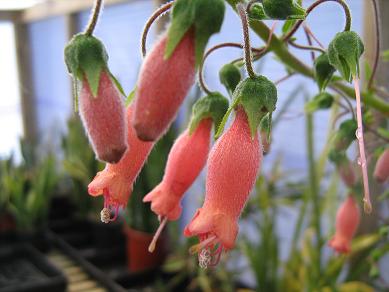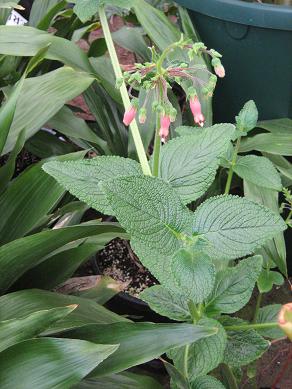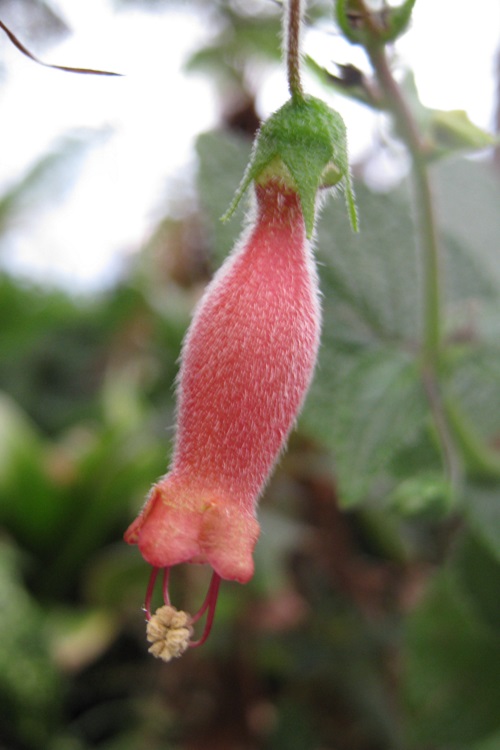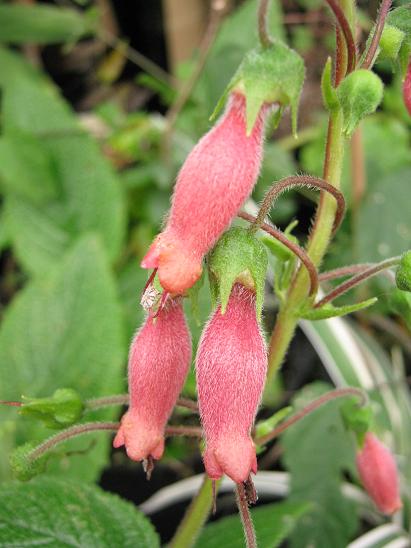 |
When I was a young thing, working as a freelance pricker-out of all things germinated, I spent innumerable hours with a tiny stick,
poking tiny holes into tiny pots of compost to accomodate the tiny seedlings of big fat Gloxinia hybrids. It has its fun moments, but they pass.
Sinningia speciosa, the fat Gloxinia in question, is intolerant of cold and shows its intolerance by rotting invisibly from the bottom up.
As a consequence I have rather neglected the other Sinningia species , which seems to have been a mistake. This one comes from southern Brazil and Argentina, and has grown easily in full sun, and flowered for months on end. The tuber has come into the greenhouse for the winter, which I hope will preserve it safely until the spring sprouts from its starchy bosom. I got a plant from Plant Delights nursery. Their catalogue says: "Yes, it's another of the amazing hardy gloxinias from South America. Sinningia sellovii is composed of thick, light green, sandpaper-like leaves on an arching clump that can reach 54" in height. Atop the plant from May through October are 4.5' arching spikes, each bearing over 100 pendent scarlet-orange bells...a hummingbird dream. Although the base of Sinningia selovii is only 2' wide after 10 years, the arching stems spread to 6' wide, so allow plenty of room. We grow our plants of Sinningia sellovii in a full sun-baked rock garden, where they thrive with good drainage...very easy." Plants of the World online says: "The native range of this species is Bolivia to Brazil and NE. Argentina. It is a tuberous lithophyte and grows primarily in the wet tropical biome." In an article for Walter Magazine, Tony Avent wrote: "Sinningia sellovii, on the other hand, remained in a tight clump and flowered nonstop from May until October. Later research revealed that Sinningia sellovii was native primarily to the hot deserts of Argentina, which explained why – despite its tender appearance and more sensitive relatives – it thrived in our hot summer climate. I subsequently also tried both of my new sinningias in part sun and light shade, and while they still produced a scant handful of flowers, they were simply not the same glorious plants they were in baking sun." Bihrmann's Caudiciforms says: "This member of the Gesneriaceae family was given this name by Hans Joachim Wiehler in 1978. It is found in north-eastern Argentina, Bolivia, Brazil, Paraguay and Uruguay, growing in a rich but well drained soil with some water and some sun. The caudex can grow to 25 or even 40 centimetres in diameter, the stems erect up to 90 centimetres, and the flowers are orange-red or even yellow. The genera is named after Wilhelm Sinning,1792–1874, a gardener of the Botanische Gärten der Friedrich-Wilhelms-Universität Bonn. The species is named after Friedrich Sellow, 1789–1831, a German botanist." |
|
| 20th July 2008 | ||




